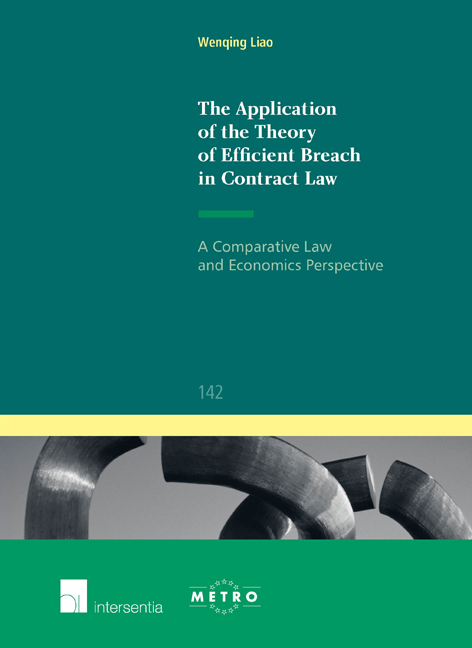 The Application of the Theory of Efficient Breach in Contract Law
The Application of the Theory of Efficient Breach in Contract Law Book contents
- Frontmatter
- Acknowledgements
- Contents
- List of Abbreviations
- List of Tables
- Chapter 1 Introduction
- Chapter 2 Economic Analysis of Contract and Contract Law
- Chapter 3 Efficient Breach in Law and Economics Theory
- Chapter 4 A Re-Examination of the Optimal Rule to Enhance Efficiency
- Chapter 5 Alternative Remedies and Efficient Breach
- Chapter 6 Efficient Breach and European Union Contract Law
- Chapter 7 Efficient Breach and Re-Negotiation in English Sales Law
- Chapter 8 Applying the Efficient Breach Doctrine to Chinese Commercial Sales Law
- Chapter 9 A Comparative Law and Economics Analysis of Efficient Breach in English Law, EU Law and Chinese Law
- Chapter 10 Concluding Remarks and Policy Recommendations
- References
- Table of legislation and European or international instruments
- Cases
- Valorization Addendum
- Ius Commune Europaeum
Chapter 6 - Efficient Breach and European Union Contract Law
Published online by Cambridge University Press: 12 December 2017
- Frontmatter
- Acknowledgements
- Contents
- List of Abbreviations
- List of Tables
- Chapter 1 Introduction
- Chapter 2 Economic Analysis of Contract and Contract Law
- Chapter 3 Efficient Breach in Law and Economics Theory
- Chapter 4 A Re-Examination of the Optimal Rule to Enhance Efficiency
- Chapter 5 Alternative Remedies and Efficient Breach
- Chapter 6 Efficient Breach and European Union Contract Law
- Chapter 7 Efficient Breach and Re-Negotiation in English Sales Law
- Chapter 8 Applying the Efficient Breach Doctrine to Chinese Commercial Sales Law
- Chapter 9 A Comparative Law and Economics Analysis of Efficient Breach in English Law, EU Law and Chinese Law
- Chapter 10 Concluding Remarks and Policy Recommendations
- References
- Table of legislation and European or international instruments
- Cases
- Valorization Addendum
- Ius Commune Europaeum
Summary
European contract law, in its definition, may be understood in a broad sense, including the rules of contract law at many different levels, such as the international, the European and the national levels. A rule of European contract law may follow from international conventions, for instance, the “UN Vienna (Sales) Convention” (or the “CISG”) or from the general principles recognized in the contract law of Member States. However, discussion about efficient breach in this chapter will be developed within a narrow scope of European law. In this thesis, the concept of European contract law only refers to the substantive contract law at the European level, namely, rules of sales contract law based on the achievements of Europeanization. This chapter will particularly focus on three European contract law instruments: the Principles of European Contract Law, the Draft Common Frame of Reference and the Common European Sales Law. At the beginning of this chapter, an introduction to the process of Europeanization in Private Law and Contract law will be provided (section 1). Afterwards, section 2 will indicate the general remedy rules within EU contract law concerning the application of specific performance, damages rules as well as party-agreed damages. The goal of this section is to answer the question of whether EU law can motivate people to perform the contract in an efficient way or not. Application of the efficient breach model with regard to performance cost will be analysed in section 3, particularly concerning how EU law deals with a contract which has fallen into the zone where strict performance is inefficient. However, application of efficient breach has its limitation within the scope of EU law measures, in relation to the nature of EU law as well as the characteristics of cross-border transactions (section 4). In section 5, an economic analysis will be provided, examining a seller's incentives to perform and to breach within EU law. Section 6 concludes.
- Type
- Chapter
- Information
- The Application of the Theory of Efficient Breach in Contract LawA Comparative Law and Economics Perspective, pp. 131 - 166Publisher: IntersentiaPrint publication year: 2015
- 2
- Cited by
